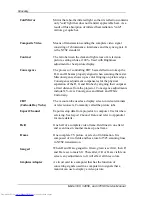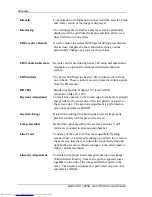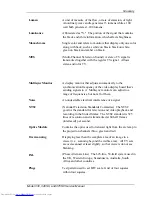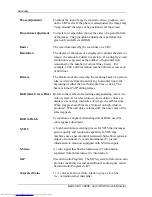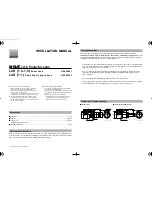
Glossary
Model 330, 340SC, and 370SC Service Manual
Cold Mirror
Mirror that absorbs infrared light so that its reflection contains
only "cold' light that does not transmit appreciable heat. As a
result of this absorption of infrared heat radiation, "cold"
mirrors get quite hot.
Composite Video
Means of transmission sending the complete video signal
consisting of chrominance, luminance and the sync signals. It
is the NTSC standard.
Contrast
The ratio between the dark and light areas of a television
picture, setting white at 100%. Used with Brightness
adjustment for best picture display.
Convergence
The process of controlling CRT beam deflection to keep the
R, G and B beams properly aligned when scanning the raster.
Misconvergence shows up as color fringing on picture edges.
Convergence adjustment compensates for the physical
separation of the R, G and B tubes by aligning their output at
a fixed distance from the projector. Convergence adjustments
include X,Y-Axis Convergence and Black and White
Uniformity.
CRT
(Cathode Ray Tube)
The vacuum tube used as a display screen in video terminals
or television sets. Commonly called the picture tube.
Export Channel
Exports setup data from projector to computer. Useful when
servicing. See Import Channel Data and refer to Appendix 1
for more details.
Field
One half of a complete video frame. Odd lines in one field
and even lines in another make up one frame.
Frame
One complete TV picture or screen of information. It is
composed of two fields and has a total of 525 scanning lines
in NTSC transmission.
Ganged
When R and B are ganged to Green, green is set first, then R
and B are set to match G. Thereafter, if R or B are visible on
screen, any adjustments to G will affect all three colors.
Graphics Adapter
A circuit card in a computer that has the function of
converting signals used in a computer into signals that a
monitor can use to display a video picture.















